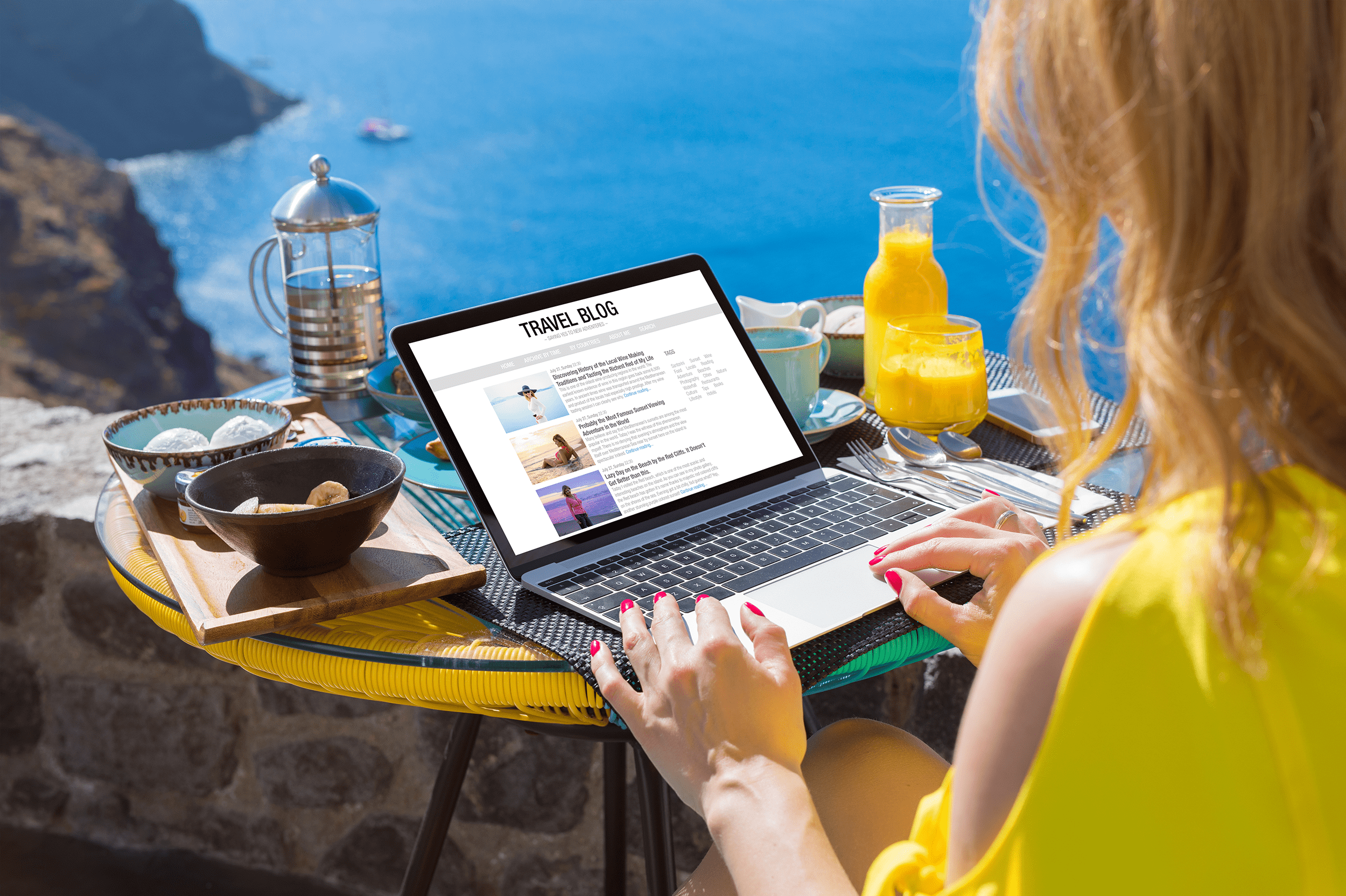As long as you’re creative or have a creative team behind you, there are virtually endless ways to bring awareness to your new product or service. Still, you might want some ideas or inspiration to help you get the ball rolling. That’s why we’ve compiled this list of 50 of the best ways to advertise a product.
To make it easier for you to figure out how to advertise your product based on your chosen medium, we’ve broken down this list into the following categories:
- Ways to Advertise in Person or Offline
- Ways to Advertise Online
- Ways to Advertise on Your Website
- Ways to Advertise on Social Media
Ways to Advertise a Product in Person or Offline

Image by Steven London from Pixabay
1. Direct Mail: Despite being an older form of marketing, direct mail advertising — or advertising a product, service, or brand via postal mail — still seems to outperform the newer-age marketing method of email. One survey found that direct mail campaigns drew in five times higher revenue per customer than email campaigns. Part of the reason mail is still successful is that customers receive much less of it than email, allowing a marketing campaign to stand out a bit more.
2. Trade Shows: Attending a trade show to highlight your new product can help you bring awareness to your brand and build potentially valuable business relationships. Plus, they’re a great way to demo your product to prospective customers or investors.
3. Customer Referrals: Give your current customers an incentive to refer your company to people they know with a solid referral program. Offer a free product or discount when they send someone new your way. To get more eyes on a specific product, advertise it on referral cards or emails about your referral program.
4. Trade-In Programs: Get people to switch to your product by offering a discount on it with an eligible trade-in of a similar product. You can also use trade-in programs to encourage customer loyalty, giving customers an opportunity to upgrade to a newer product at a discount by trading in their old one.
5. Billboards: According to Statista, billboards have the highest out-of-home advertising reach. People spend a lot of time in their cars, and a well-designed billboard advertising your product can easily catch the attention of passers-by.
6. Magazine Ads: Print magazines may not be as widely read as they once were, but digital versions have kept magazines relevant. Interestingly, about 58% of magazine readers trust magazines, compared to 42% trusting websites and 34% trusting ad-supported TV networks.
7. Text Messages: Offer exclusive discounts for your product to customers who have signed up for text message alerts. SMS marketing can be an excellent way to reach new and current customers, with 91% of consumers saying they’d opt-in to text messages from brands.
8. Real-World Product Demos: Find events in your area where you could demo a product, like business expos or in retail stores. Sometimes, seeing a product in action is all someone might need to decide to purchase it.
9. Packaging Inserts: When a customer orders something from you, add a packaging insert to their shipping box with an exclusive offer for your new product. Make the deal something that’s difficult to pass up, like BOGO or 25% off a purchase.
10. Community Event Sponsorships: Let your brand become the sponsor of a community event, sports team, etc. Be sure to add information about your new product to sponsorship materials, like signage, flyers, or emails.
11. Radio Advertisements: Radio can be one of the most cost-effective forms of advertising, but only if you find the right audience for your ads. Choose stations your ideal audience listens to to determine the best spots for your product ads.
Ways to Advertise a Product Online

Photo by RODNAE Productions
12. Press Releases: When you have a new product to share with the world, send out a press release. You’ll have complete control over the information you share, and you can get your product in front of your ideal audience quickly.
13. Online Product Demos: You might have tried an in-person product demo, but you can also host one online. For SaaS products, offer free demos for prospective customers on your website. For other products, create a demo video or written tutorial with photos showing it in action.
14. Virtual Launch Party: Let your followers meet you online for a virtual launch party on Twitter, Facebook, Instagram, Zoom, or another channel where your audience hangs out a lot. It’s a great way to build buzz around your new product.
15. Website Advertising: Advertise your product on relevant websites by using advertising networks or contacting website owners directly. You can do this through banner ads or sponsored blog posts, for example.
16. Product Videos: Share videos of your product on YouTube or your website. Let people know how to use it, what problems it solves, or tell creative stories of it and how it fits into your brand or industry.
17. Google Ads: Get your product on the face of Google with Google Ads. If you earn one of the top three ad spots on Google’s front page for your keyword, you could get plenty of traffic to your product page. Research shows that the top three paid ads earn 46% of the clicks on that page.
18. Email Marketing: Many marketers find success with email marketing, but it can take a while to build that success. If you haven’t already built a list, start now. Let your subscribers know about your new product and offer a special discount to encourage them to buy.
19. Influencer Partnerships: Partnering with influencers to share what they love about your product lets you piggyback off the influencers’ audiences. And, it might pay off to work with microinfluencers, or influencers with smaller audiences. According to Influencer Marketing Hub, microinfluencers charge less but their authenticity can make a big impact on their audiences.
20. Customer Reviews: Encourage your customers to leave reviews of your product on your website or other websites where they might purchase your product. They can also review your company on Google or Facebook. Don’t forget to remind them to contact your company if they have a concern or problem before leaving a negative review.
22. Promo Codes: Release promo codes for customers to use on your product. Coupon sites will pick them up and advertise them for you, drawing potential sales without you having to spend a dime.
23. Free Sample Sites: Become an advertiser on sites that give free samples to account holders. You can offer free samples of your product in exchange for reviews or social posts from samplers, which basically leads to free advertising.
24. Influencer Networks: Partner with influencer networks that connect brands to influencers with large, specific followings. Find the right influencers to promote your product, and you’ll reach a whole new audience.
25. Google Shopping: Get your product in Google Shopping results. You’ll need a Google Merchant Center account to get started. Add your products and link your Google Ads account to set up search campaigns. Your product can then show up on relevant search pages.
26. Affiliate Program: Create an affiliate program for your brand with specific campaigns for your new product. Affiliates have the incentive to promote your product to earn commissions from sales.
27. Remarketing: Use remarketing by gathering information from your website visitors. These visitors are already interested in what you offer, so they could very well become customers again. Use your customer list to remarket to those customers via ads that display on other websites. Learn how to set up Google Remarketing.
28. Sell in Marketplaces: Place your product on Amazon, eBay, and other online marketplaces to get more eyes on it.
Ways to Advertise a Product on Your Website

29. Referral Program: A referral program entices people to talk or share information about your product or brand with people they know. Offer something special to those who let others know about your new product, like money off their next purchase.
30. Loyalty Program: Create a loyalty program on your website that encourages customers to keep buying your products. Perhaps they can earn points toward a free product or earn a discount each time they place an order.
31. Internal Advertising: Advertising doesn’t always have to happen off your website. You can also advertise on your own website by linking internally to your product from a blog post or adding a banner ad for your product to your home page.
32. Upgrades or Add-Ons: Advertise your product at checkout, which could attract people who may have missed it on your website. To upsell on the checkout page, offer a discount to add your product to the cart or mention it as an upgrade for a discounted amount.
33. Gift Guides: Share gift guides that resonate with your audience for special dates or holidays. In them, include your product. These work well because, although they’re promotional in nature, they don’t feel like marketing if done correctly. If you have several relevant products to include in your gift guide, you might also go more of a curation route that highlights those products, like this guide to wine gifts from Uncommon Goods.
34. Online Discounts or Promotions: Showcase discounts and promo codes for your product for website visitors in easy-to-spot places, like at the top of your website or in a large focus image. You can also gift exclusive discounts for signing up for your email list through your website.
35. Customer Reviews: Encourage people who have bought your product to leave reviews on your website, which can be excellent free advertising. Use your email marketing software to send follow-up reminders after someone places an order. In the reminder, include a discount or exclusive offer for customers who leave a review.
36. Giveaways: Even though you give away your product for free in a giveaway, giveaways can draw a lot of attention to your product. Create one on your website that gives people entries for tasks like sharing a video of your product or posting about the giveaway on their social media channels.
37. Blog Posts: Write blog posts about your product or link to your product from relevant blog posts. With 77% of internet users still reading blogs, it’s clear that blogging works. Not sure how to get started with blogging? Learn how to create a blog post in 9 steps.
38. Recommend Products: When a website visitor reaches a section of your page or another product page that’s relevant to the product you want to advertise, include a recommendation for your product on the page. Be sure to add an image and clear messaging indicating your suggestion. Some websites use appealing messaging, like, “People interested in this also bought this product…” to encourage people to click over.
Ways to Advertise a Product on Social Media

Photo by George Milton
39. Social Media Ads: Facebook, Instagram, Snapchat, and most other social media channels allow ad creation for businesses and influencers. Check out our social media guides to learn more about creating ads on the most popular social media platforms.
40. Giveaways: Similar to giveaways on your website, you can also do giveaways on social media. For instance, companies on Facebook create giveaway posts encouraging viewers to follow their pages and share the post for entries. These tasks can grow Facebook pages and post reach organically, getting more eyes on your product.
41. Influencer Partnerships: Reach out to influencers on your chosen social media channels to have them promote your product, giving you access to their audience, too.
42. Cross Promotion: Leverage your multiple social media channels by cross-promoting giveaways, tutorials, and other content about your product on other platforms. For example, you might write a post on Twitter introducing and linking to a YouTube video you created for your product. You can also partner with other (non-competitor) brands or non-profit organizations for cross-promotion campaigns.
43. Share Exclusive Discounts: Social media platforms are ideal for releasing exclusive discount codes or flash sales for your followers. It’s easy to promote them on social media, especially with a large following, and it could lead to instant sales.
44. Product Tagging: Instagram allows you to tag products in your Instagram posts. You can set up product tagging with an Instagram business profile and Facebook Commerce Manager account.
45. Stories: Anyone can now add links to Instagram Stories. Use the feature to link to your products alongside a video clip or image of your product.
46. Use Calls-to-Action: Add CTAs to blog posts or social media posts that are relevant to your product. Example: “Get the bundle” or “Buy now for 10% off.”
47. Create Branded Hashtags: Create an all-new hashtag for your product to use on social media. Any time you post about your product, use your hashtag and ask partnered influencers to do the same. This makes it easy for people interested in your product to see what others have to say about it.
48. Host a Live Stream: Show off your product in a social media live stream. Facebook, Instagram, TikTok, and other top social media platforms allow live streaming. Live steaming grew by 99% from April 2019-April 2020 alone and is expected to become a $149.34 billion industry by 2026.
49. Twitter Party: Create buzz around your product with a Twitter party. Twitter parties have an exclusive hashtag that participants and hosts use to gather everyone together for live-tweeting about a specific topic. Usually, the hosts sprinkle giveaways throughout the party to encourage participation. Twitter parties are great for announcing a product, explaining its benefits, and answering questions about it.
50. Create Pinterest Boards: Make Pinterest boards that can feature your product and the content you’ve created about it. Learn how to promote your business with Pinterest and helpful Pinterest marketing tips.
One of the best ways to boost your advertising success is to grow your following to have a larger audience to market to. Install share buttons to make it easy for website visitors to share your product pages, blog posts, unboxing videos, gift guides, and other product-related content on their favorite social media platforms with a single click. Not only will it help boost brand awareness, but it will also help you boost sales!




